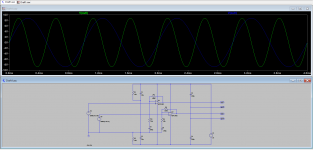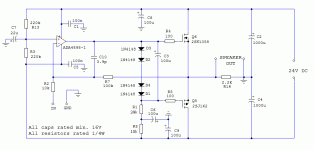Most op amps say +- 18VDC as a max. I suppose I could regulate it down to something less than 18VDC, ground the -VCC and bias via 1/2 VCC, but is there an easy way to use the full 24 volts?
Yes. Bootstrap it.
https://www.diyaudio.com/community/...-easy-peasy-70v-peak-peak-opamp-for-1.314456/As an example, here is JRC5534 running on +/-44v rails.

Or you can simply run from single 24v rail and AC couple the output. You will only have 24vpp.
There are also lots of HV opamps. Like OPA454. I use that with +/-35v and it works beautifully.
You can also get a 6v drop on each rail with a string of diodes at 0.6v ea x 10. Kind of unsightly but 20 tiny little SMT ones won’t look quite so messy.
https://www.diyaudio.com/community/...-easy-peasy-70v-peak-peak-opamp-for-1.314456/As an example, here is JRC5534 running on +/-44v rails.
Or you can simply run from single 24v rail and AC couple the output. You will only have 24vpp.
There are also lots of HV opamps. Like OPA454. I use that with +/-35v and it works beautifully.
You can also get a 6v drop on each rail with a string of diodes at 0.6v ea x 10. Kind of unsightly but 20 tiny little SMT ones won’t look quite so messy.
Perhaps a better virtual ground is one where the input and therefore bias virtual ground is separated from the output virtual ground. Multiple outputs can share the output ground provided there is no significant DC offset between them. Connecting input and output virtual ground can work, especially if an op-amp with enough current capacity is used to create the virtual ground. Note that the "virtual ground" is actually ground, and it is the floating rail voltages that are ~regulated. Note this is a good way to use single ended power amps with a single voltage supply.
Attachments
Last edited:
Sorry but you are mixing contradictory statements.Most op amps say +- 18VDC as a max. I suppose I could regulate it down to something less than 18VDC, ground the -VCC and bias via 1/2 VCC, but is there an easy way to use the full 24 volts?
Please confirm/deny:
1) +/-18V means split rails, which imply 36V total/end-to-end (typically from pin 8 to pin4 in a dual Op Amp)
2) "it" suggests a single rail , 18V total
3) full 24V again suggests a single rail, 24V total, and very different from the 18V or 36V mentioned above.
So, which one are we talking about?
Sorry! Meant to clarify my first post. I'm talking a single rail 24VDC power brick. I am assuming I will have to do 1/2Vcc as a bias point. I ask if there's a better way because I would like to feed it with max voltage from with what I have available (without frying the opamp).
I assume I will have to just regulate my (single rail 24VDC) to 18V or less and ground the chip's -Vcc pin to use it safely. But, I'm curious if there's another clever way to use the full 24vdc (single rail).
Virtual ground won't work in this case because I'm sharing the supply with later stages that will use the 0-24V with the 0v as ground.
I assume I will have to just regulate my (single rail 24VDC) to 18V or less and ground the chip's -Vcc pin to use it safely. But, I'm curious if there's another clever way to use the full 24vdc (single rail).
Virtual ground won't work in this case because I'm sharing the supply with later stages that will use the 0-24V with the 0v as ground.
Last edited:
There are many methods for powering an op-amp from a single supply. If you like reading, here's some good info...
https://www.ti.com/lit/an/sloa030a/sloa030a.pdfhttps://www.analog.com/media/en/ana...cles/avoiding-op-amp-instability-problems.pdf
You can also look into rail splitting methods to create a dual supply.
If you want a true dual supply, I've used this one in a few projects. It's small, reliable, and reasonably priced...
https://www.ebay.com/itm/182292179749
https://www.ti.com/lit/an/sloa030a/sloa030a.pdfhttps://www.analog.com/media/en/ana...cles/avoiding-op-amp-instability-problems.pdf
You can also look into rail splitting methods to create a dual supply.
If you want a true dual supply, I've used this one in a few projects. It's small, reliable, and reasonably priced...
https://www.ebay.com/itm/182292179749
The best possible headroom may be slightly off 1/2 VCC - op amps can usually get a bit closer to one rail compared to the other. Maybe a volt of difference, and which way depends on which op amp.
You may get better results with just a voltage divider and cap compared to a rail splitter IC. The IC solution may have increased output impedance as frequency rises, and may not like capacitive loads. The passive solution will never go unstable on you but does have turn on/off transients that need to be managed.
You may get better results with just a voltage divider and cap compared to a rail splitter IC. The IC solution may have increased output impedance as frequency rises, and may not like capacitive loads. The passive solution will never go unstable on you but does have turn on/off transients that need to be managed.
... I'm talking a single rail 24VDC power brick. ...
Voltage divider is a usual way to do it. Schematic shows how to do it for the whole amp, without coupling caps. Leave the output stage out if you need to power just the OpAmp. Explaned here
Attachments
Last edited:
- Home
- Amplifiers
- Solid State
- Best way to power an opamp with 24VDC?

